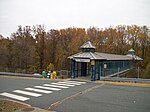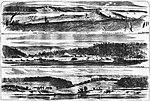Featherstone National Wildlife Refuge
1970 establishments in VirginiaIUCN Category IVLandforms of Prince William County, VirginiaNational Wildlife Refuges in VirginiaPrince William County, Virginia geography stubs ... and 5 more
Protected areas established in 1970Protected areas of Prince William County, VirginiaVirginia protected area stubsWetlands of VirginiaWoodbridge, Virginia

The Featherstone National Wildlife Refuge is a National Wildlife Refuge located along the Potomac River in Virginia, at the point where it meets Neabsco Creek. The 325 acres (1.32 km2) of tidal marsh has been administered by the United States Fish and Wildlife Service since 1970; currently, it is part of the Potomac River National Wildlife Refuge Complex. The refuge covers wetlands and woodlands, and has a railroad right-of-way bordering its western edge. It is currently accessible only by boat, but has been considered as a possible portion of the route for the Potomac Heritage National Scenic Trail.
Excerpt from the Wikipedia article Featherstone National Wildlife Refuge (License: CC BY-SA 3.0, Authors, Images).Featherstone National Wildlife Refuge
Neabsco Beach Way,
Geographical coordinates (GPS) Address Nearby Places Show on map
Geographical coordinates (GPS)
| Latitude | Longitude |
|---|---|
| N 38.594444444444 ° | E -77.255555555556 ° |
Address
Leesylvania State Park
Neabsco Beach Way
22191
Virginia, United States
Open on Google Maps





